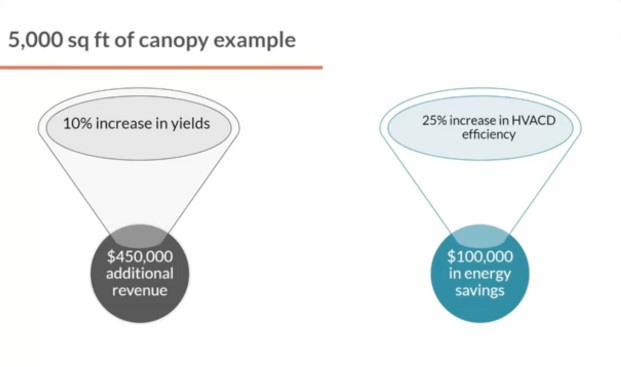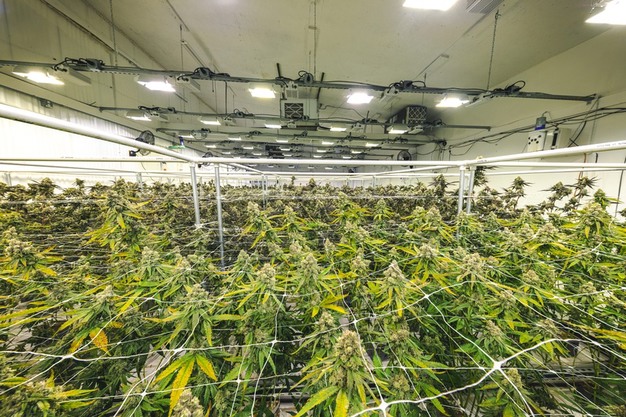In the controlled environment cannabis space, your HVACD system is not just another line item in the budget, it's the backbone of your operation. That was the central message delivered by Chip Seidel, dehumidification specialist at Desert Aire, during a recent webinar hosted by the Resource Innovation Institute (RII) and NYSERDA.
Chip likened HVAC systems to the drivetrain of a cultivation facility, explaining that every component, especially lighting, impacts the climate and triggers plant transpiration. He also mentions how crucial control over VPD as it dictates how optimal plant performance can be. If the air isn't dry enough, plants can't transpire efficiently, leading to stunted growth and reduced yields. The key to keep everything under control is obviously to have all pieces of equipment to work flawlessly constantly. To achieve that, PM or preventative maintenance is the way to go. Through that, your systems will run less efficiently, cost more, and break down sooner, he says.
To illustrate the stakes, Chip shared a case study of a 5,000-square-foot canopy operation that upgraded its HVAC system. The result was a 10% boost in yield, translating to $450,000 in additional revenue, and a 25% drop in energy consumption, saving the grower another $100,000 annually.
 © Resource Innovation Institute
© Resource Innovation Institute
When evaluating HVACD options, Chip urged growers to look for manufacturers with a proven track record in CEA. Too often in the early days of regulated cannabis, he said, companies installed equipment designed for other sectors, which simply can't keep up with the dynamic demands of a cannabis grow. Equipment should be purpose-built, with full consideration of the total installed cost, including ducting, sensors, and the commissioning process. Importantly, many regions offer rebates tied to energy efficiency, so growers should work closely with HVAC and lighting partners to explore incentives.
Three HVACD categories
Chip broke down HVACD options into three main categories. The first is a traditional air conditioning system paired with standalone dehumidifiers. This setup has the lowest upfront cost but comes with higher energy use and maintenance needs, since the two systems operate separately. Then there are integrated direct expansion (DX) systems, which combine cooling, heating, and dehumidification in a single unit. These cost more up front but offer better control, energy savings, and lower maintenance. Finally, chilled water systems offer the highest energy efficiency and lowest long-term operational cost, though they require a significant initial investment and are best suited for large-scale operations with the infrastructure to support them.
The role of geography locations
Geography also plays a significant role in system design. In colder climates, chilled water systems may be able to leverage ambient temperatures to improve efficiency. For growers in dusty environments, for instance, dirt and airborne contaminants may require additional maintenance of their equipment. It all comes down to where such systems are located, whether outside, on the roof, and so on. Selecting their place should anyway be based on facilitating both performance and upkeep. As he mentioned, a grower should always prefer to work with manufacturers that have experience in cannabis CEA and a proven track record of successful project as they'd be capable of advising the growers of the best way to grow.
Maintenance
With regards to maintenance, Chip was blunt: skip it, and you'll pay for it later. Key components like refrigeration systems, fans, coils, and filters must be checked and cleaned regularly. For instance, coils can get clogged with debris which means they won't be able to transfer heat effectively, leading to system inefficiencies and failures. Filters, in particular, are often neglected. "Most people don't change them nearly as often as they should," he said. He even suggests changing them at the end of every grow cycle.
Sensor calibration is another aspect. This should be carried out on an annual basis, and Chip said to invest in a reliable handheld meter to spot check grow room readings. As always, collaborating and talking with your manufacturer during commissioning to make sure all sensors are placed and configured in a correct fashion.
Remote diagnostic capabilities are becoming a must-have feature. These systems allow operators to monitor things such as suction line pressure, discharge pressure, valve positions, and so on, all from a centralized interface. This not only tightens climate control but also reduces labor demands and helps flag problems before they escalate.
 © Openrangestock | Dreamstime
© Openrangestock | Dreamstime
How to select the right manufacturer
Serviceability was another major theme. Smaller operations may rely on external contractors, while larger grows benefit from in-house HVAC expertise. Some manufacturers, Desert Aire included, offer training classes to their customers, as well as weekly calls, especially if they are dealing with a large operation. He said that growers should fully take advantage on such things, and stressed multiple times to capitalize on these knowledge transfer opportunities.
It's important to keep on being in contact with your manufacturer, not just for training or for getting suggestions on the most useful spare parts a grower may want to have available. Things are always moving in the cannabis industry, and it may be that a grow decides to go from 1 tier to 2 tiers, or perhaps a new cultivator has joined and wants to adjust some cultivation processes. All these changes to the grow room requires the HVACD to be adjusted accordingly to always allow the plants to fully express their potential and allow a grower to carry out their craft at the best of their ability.
One of the worst dreaded moments by cannabis growers is HVACD downtime. In a high-stakes crop like cannabis, downtimes aren't just inconvenient, it can significantly impact a grower's bottom line. To minimize the risk, diligent preventative maintenance comes back into the picture, as well as remote monitoring, and strong relationships with both manufacturers and local service partners. Chip encouraged growers to invest in training for both cultivators and technicians.
Ultimately, the point is that when it comes to HVACD systems, cutting corners on maintenance and design will cost growers more than actually take care of their equipment. With the right investment and support, growers can achieve tighter environmental control, reduce costs, and protect their crops, to improve their cultivation and their margin exactly like the example of the grower Chip mentioned at the beginning of his presentation.
For more information:
Resource Innovation Institute
www.resourceinnovation.org










